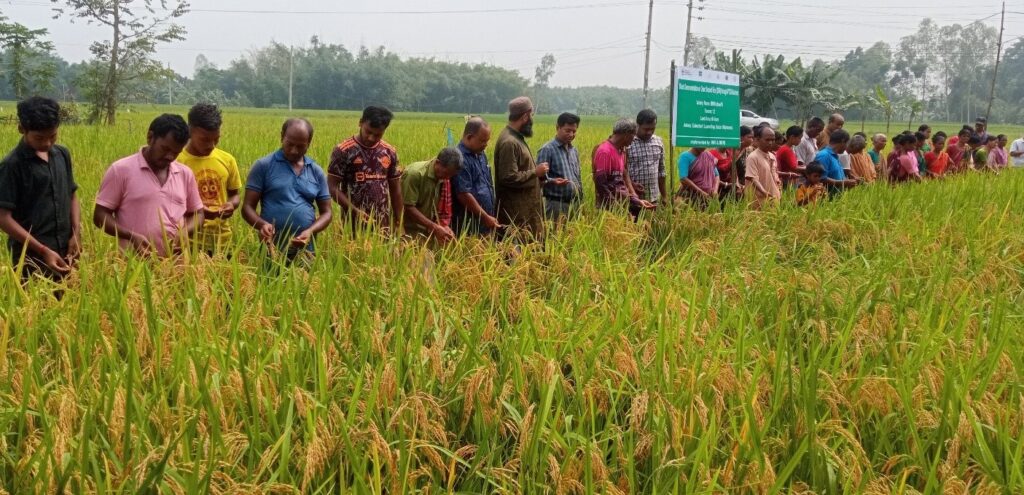by Sharif Ahmed and Humnath Bhandari
Including mixed farming systems in traditional agricultural systems has potential benefits for farmers, especially for smallholder and marginal farmers. It not only helps farmers diversify from the production of grains to vegetables and the rearing of livestock thus resulting in dietary diversity of the farmers, but also helps increase their net profitability, enhances soil health, and leads to environmental sustainability and improvement in overall biodiversity.

.
The agricultural sector plays an important role in the overall development of Bangladesh in terms of gross domestic production (GDP) and employment. Most people in the country rely on agriculture for their livelihood directly or indirectly.
Rice, the staple food for Bangladesh, is grown in more than 70% of the total cultivated area with mono-cropping as the dominant crop production system practiced by smallholder farmers.
Farm-productivity ceiling
Rice mono-cropping has disadvantages such as low income, high water usage, and limited dietary diversity for farmers. Bangladeshi farmers also primarily practice subsistence farming and have almost reached the full potential of rice productivity with little room for further increasing the yields of small farms.
To work around the margins of rice mono-cropping, smallholder farmers and landless rural households with small homestead areas raise cattle, buffalo, goats, and poultry for household consumption. The animals are fed with crop residue but because of small farm sizes, livestock feed is also available in small quantities.
Reducing risks with mixed farming
Through the Sustainable Intensification of the Mixed Farming Systems (SI-MFS) Project, the International Rice Research Institute (IRRI), in collaboration with its national partners, designed and is implementing more than 10 farming innovations that allow the farmers to diversify their income by combining crop and livestock production.
The project activities include crop intensification and diversification practices which help reduce the financial risks that come from depending solely on a single crop with livestock.
The integration of farming and livestock rearing creates a mutually beneficial relationship. The livestock consumes agricultural by-products, crop residues, and kitchen waste saving farmers in feed costs. In turn, animal manure can be used as fertilizer to increase crop productivity through nutrient recycling. In addition, the integration of legume crops in the cropping system increased the soil nitrogen thereby reducing farmers’ reliance on synthetic fertilizers. This synergy helps facilitate sustainable and efficient use of resources.
Promoting composting and vermicomposting can help improve vegetable production and enhance soil fertility.
Farmers can produce organic vegetables in homestead areas year-round by adopting these innovations. Encouraging farmers to engage in diversified vegetable production enhances food security and improves nutrition.

An empowering agricultural system
SI-MFS empowers farmers to meet their household needs, generates higher income, and increases their reliance on homegrown food. Vegetable production has the added benefit of empowering women as kitchen gardens are mainly their responsibility.
The project undertakes various activities to promote investment in livestock by training farmers in sustainable and nutritious livestock fodder production, effective management of grazing lands, and alternative feed sources for increased milk and meat production. These are essential for improving the livelihoods of small farmers and enabling them to contribute to the local economy.
SI-MFS underscores the importance of building climate resilience and adaptation among farmers through climate-smart and climate-resilient agriculture techniques and promoting maize intercropping and agroforestry.
Intercropping maize with other crops such as legumes and vegetables increases the farmers’ profitability through increased yield and improved soil health. This practice not only provides additional income but also optimizes available land resources, contributes to food and nutrition security, and increases the economic resilience of farmers.
Agroforestry practices such as integrating fruit trees and nitrogen-fixing trees can contribute to income diversification, promote soil health, reduce erosion, improve microclimate, and enhance biodiversity.
The SI-MFS project also includes training involving agricultural techniques like direct seeding of rice, simultaneously growing dryland and wetland crops in the same field, better crop nutrition, using nano fertilizers, and others. SI–MFS has organized numerous training and technology demonstrations to enhance farmers’ knowledge of mixed farming principles.

Driving economic growth through women and the youth
With the growing recognition of how women and youth-led enterprises can help build resilient economies, SI-MFS taps these underutilized sectors by providing them with livelihood options. Women and young people are trained as local service providers for small agricultural machines such as fodder choppers, maize shellers, oil extractors, seeding machines, and mini rice husking mills.
The project links them with local farming communities to promote their business which supports the sustainable implementation of mixed farming systems.
Through innovative interventions, SI-MFS can transform the small farms in Bangladesh eliminating the barriers that keep its agricultural sector from reaching its full potential and, ultimately, moving it towards a more sustainable and stable future.
The SI-MFS Initiative is one of 32 new research and development Initiatives by CGIAR. It aims to provide equitable and gender-transformative approaches to improve the livelihoods of smallholder farmers who engage in mixed farming systems across six countries, including Ethiopia, Ghana, Malawi, Laos PDR, Bangladesh, and Nepal.






